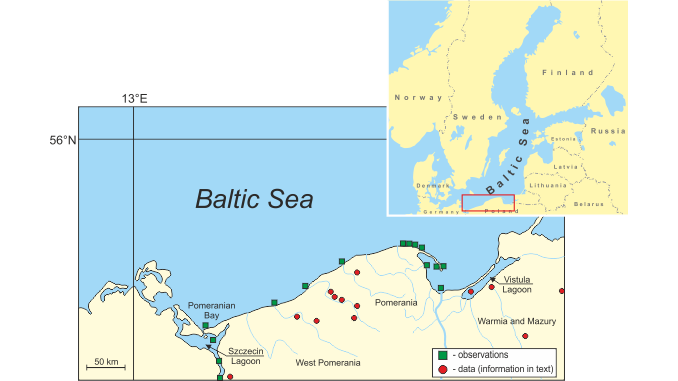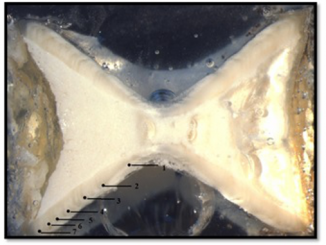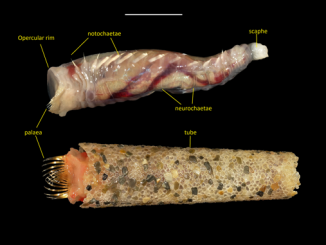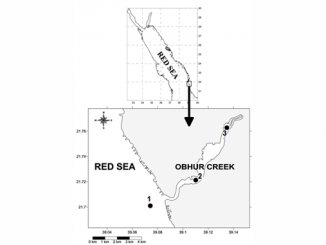
Paper category: Review paper
Corresponding author: Aldona Dobrzycka-Krahel (oceadk@ug.edu.pl)
DOI: 10.1515/ohs-2017-0044
Received: March 23, 2017
Accepted: May 29, 2017
Full text: here
Citation (APA style):
Abstract
The aim of this work was to assess the adaptive capabilities of the spiny-cheek crayfish Orconectes limosus (Rafinesque, 1817) in the open coastal waters of the Baltic Sea. The results could help to predict the likely further expansion of this species and its colonization of brackish waters. The following aspects were discussed in the paper: the occurrence of the species in the Polish coastal zone of the Baltic Sea, the plasticity demonstrated in the body size of individual crayfishes, food preferences, hemolymph osmolality and reproduction in waters of different salinities, which enable the species to colonize brackish waters. In the Vistula Lagoon (salinity 2-3 PSU), where the population of O. limosus is stable, the length of individuals ranged from 77 to 118 mm. These crayfish mostly fed on fodder; the second and the third food preferences were crayfish abdominal muscle and green algae. O. limosus is a hyper-regulator in freshwaters and at low salinities (up to 13 PSU), and a hyporegulator at higher salinities (14, 21, 28, 35 PSU). Laboratory studies showed that the embryonic development of O. limosus at salinities of 3 and 7 PSU was normal and a high level of reproductive success was achieved. Salinity of 3 PSU is more favorable for the development of juveniles than 7 PSU. It seems to be just a matter of time before this crayfish starts to form populations in the brackish, coastal waters of the Baltic Sea.
References
Anger, K., Spivak, E. & Luppi, T. (1998). Effects of reduced salinities on development and bioenergetics of early larval shore crab, Carcinus maenas. J. Exp. Mar. Biol. Ecol. 220: 287-304. DOI: 10.1016/S0022-0981(97)00110-X.
Anger, K. (1990). Der Lebenszyklus der Chinesischen Wollhand krabbe (Eriocheir sinensis) in Nord-deutschland: Gegenwärtiger Stand des Wissens und neue Untersuchungen. Seevögel 11(2): 32-37.
Andrews, E.A. (1907). The young of the crayfish Astacus and Cambarus. Smithsonian Contribution to Knowledge 35: 1718-1779.
Aquiloni, L., Tricarico, E. & Gherardi, F. (2010). Crayfish in Italy: distribution, threats and management. International Aquatic Research 2: 1-14.
Arbačiauskas, K. (2005). The distribution and local dispersal of Ponto-Caspian peracarida in Lithuanian fresh waters with notes on Pontogammarus robustoides population establishment, abundance and impact. Oceanol. Hydrobiol. St. 34, Supplement 1: 93-111.
Arens, A. & Taugbøl, T. (2005). Status of freshwater crayfish in Latvia. Bulletin Francais de Management. International Aquatic Research 2: 1-14.
Bohl, E. (1999). Crayfish stock situation in Bavaria (Germany) – attributes, threats and chances. Freshwater Crayfish 12: 765-777.
Bonsdorff, E. & Person, T.H. (1999). Variation in sublittoral macrozoobenthos of the Baltic Sea along environmental gradients: a functional – group approach. Australian J. Ecol. 24: 312-326.
Briede, I. (2011). Crayfish in Latvia. Acta Biol. Univ. Daugavpiliensis 11: 83-87.
Burba, A. (2008). Orconectes limosus found along the Lithuanian Coastal zone of the Baltic Sea. Crayfish NEWS, IAA Newsletter 30(2): 6-7.
Buřič, M. (2009). Biology of spiny-cheek crayfish (Orconectes limosus, Rafinesque, 1817) under conditions of the Czech Republic and the study of factors influencing its invasive spreading. Unpublished doctoral dissertation. USB Faculty of Fishery and Water Protection, Research Institute of Fish Culture and Hydrobiology. Vodňany, Czech Republic, 145 p. ISBN: 978-80-85887-83-9.
Buřič, M., Kouba, A. & Kozák, P. (2010). Molting and Growth In Relation to form Alternations In the Male Spiny – Cheek Crayfish Orconectes limosus. Zoological Studies 49(1): 28-36.
Buřič, M., Kouba, A. & Kozák, P. (2009). Spring mating period in Orconectes limosus: the reason for movement. Aquat. Sci. 71: 473-477.
Buřič, M., Kouba, A. & Kozák, P. (2013). Reproductive plasticity in freshwater invader: from long-term sperm storage to parthenogenesis. PLOS ONE 8(10): 1-7.
Carlton, J.T. (2009). Deep invasion ecology and the assembly of communities in historical time. In G. Rilov & J.A. Crooks (Eds.), Biological Invasions in Marine Ecosystems (pp. 13-56). Berlin. Springer-Verlag.
Chucholl, Ch. (2013). Invaders for sale: trade and determinants of introduction of ornamental freshwater crayfish. Biological Invasions 15(1): 125-141. DOI: 10.1007/s10530-012-0273-2.
Chybowski, Ł. (2000). Proporcje ciała raka sygnałowego (Orconectes limosus Raf.) i sygnałowego (Pacifastacus leniusculus Dana) [Abstract], In J. Mastyński & W. Andrzejewski (Eds.), Actual situation of crayfish in Poland (pp. 29-30). I-st Symposium of Astacilogists, Agricultural Academy, Poznań. 6 Oct. 2000 (In Polish).
Cieśliński, R. (2010). Zróżnicowanie typologiczne i funkcjonalne jezior w polskiej strefie brzegowej południowego Bałtyku. Problemy Ekologii Krajobrazu: TXXVI: 135-144.
Cognetti, G. & Maltagliati, F. (2000). Biodiversity and Adaptive Mechanisms in Brackish Water Fauna. Marine Pollution Bulletin 40: 7-14.
Crome, W. (1955). Flusskrebse – Natur and Heimat H 10: 318-319.
Dobrzycka, A. & Szaniawska, A. (1995). The effect of salinity on osmoregulation in Corophium valutator (Pallas) and Saduria entomon (Linnaeus) from the Gulf of Gdansk. Oceanologia 37(1): 111-122.
Dobrzycka-Krahel, A. & Szaniawska, A. (2005). The effect of hypoxia and anoxia on osmotic concentration of Corophium volutator (Pallas) from the Gulf of Gdańsk. Oceanol. and Hydrobiol. St. 34(1): 9-109.
Dobrzycka-Krahel, A. & Szaniawska, A. (2007). The effect of hypoxia and anoxia on osmotic and ionic regulation in the brackish water isopod Saduria entomon (Linnaeus) from the Gulf of Gdańsk. Journal of Shellfish Research 26(1): 147-152. DOI: 10.2983/0730-8000(2007)26[147:TEOHAA]2.0.CO;2.
Ďuriš, Z., Drozd, P., Horká, I., Kozák, P. & Policar, T. (2006). Biometry and demography of the invasive crayfish Orconectes limosus in the Czech Republic. Bull. Fr. Pêche Piscic. 380-381: 1215-1228.
Gajewski, Z. & Terlecki, W. (1956). Raki. PWRiL. 196p.
Geelen, J.F.M. (1978). The distribution of the crayfishes Orconectes limosus (Rafinesque) and Astacus astacus (L.) (Crustacea, Decapoda). In The Netherlands. Bijdragen tot de Faunistiek van Nederland 5. Zoologische Bijdragen 23: 4-19.
Gherardi, F. & Cioni, A. (2004). Agonism and interference competition in freshwater decapods. Behaviour 141 (10): 1297-1324. DOI: 10.1163/1568539042729702.
Głowaciński, Z. (2011). Introdukcja i mechanizmy sprzyjające inwazji zwierząt (Introduction and mechanisms favoring alien animal invasions). In Z. Głowaciński, H. Okarma, J. Pawłowski & W. Solarz (Eds.), Gatunki obce w faunie Polski. II Zagadnienia problemowe i syntezy (pp. 653-670). Instytut Ochrony Przyrody PAN, Kraków.
Głowaciński, Z., Okarma, H., Pawłowski, J. & Solarz, W. (2011). Metodyka i terminologia. In Z. Głowaciński, H. Okarma, J. Pawłowski & W. Solarz (Eds.), Gatunki obce w faunie Polski (pp. 24-28). Instytut Ochrony Przyrody PAN, Kraków.
Goddard, J.S. (1988). Food and feeding. In D.M. Holdich & R.S. Lowry (Eds.), Freshwater crayfish: biology, management, and exploitation (pp. 145-1660). Croom Helm, London.
Groβ, H., Burk, C. & Hill, A. (2008). Die Flusskrebsfauna in NRW. Natur in NRW 4: 51-56.
Gruszka, P. (1999). The River Odra estuary as a gateway for alien species immigration to the Baltic Sea basin. Acta Hydrochim. Hydrobiol. 27(5): 374-382.
Guan, R.Z. & Wiles, P.R. (1999). Growth and reproduction of the introduced crayfish Pacifastacus leniusculus in a British lowland river. Fish Res. 42: 245-259.
Hamr, P. (2002). Orconectes. In D.M. Holdich (Ed.) Biology of Freshwater Crayfish (pp. 585-606). Blackwell Science LTD, Oxford.
Haroon, A.M. & Szaniawska, A. (1995). Variations of energy values and lipid content in Enteromorpha spp. from the Gulf of Gdansk. Oceanologia 37: 171-180.
Hernández-Muňoz, S., Mejiia-Ortiz, L.M. & Viccon-Pale, J.A. (1999). Feeding behaviour of the crayfish Procambarus mexicanus under laboratory conditions. Freshwater Crayfish 12: 252-260.
Heese, T. (2013). Nowe stanowisko raka sygnałowego w wodach otwartych – dolna Wieprza. Przegląd Rybacki 1: 3-5.
Hobbs, H.H. (1988). Crayfish distribution, adaptive radiation and evolution. In D.M. Holdich & R.S. Lowery (Eds.), Freshwater Crayfish: Biology, Management and Exploitation (pp. 52-82). London: Croom Helm.
Holdich, D.M., Harlioglu, M.M. & Firkins, I. (1997). Salinity adaptations of crayfish in British waters with particular reference to Austropotamobius pallipes, Astacus leptodactylus and Pacifastacus leniusculus. Estuarine, Coastal and Shelf Science 44: 147-154. DOI: 10.1006/ecss.1996.0206.
Holdich, D.M., Haffner, P., Noël, P., Carral, J., Füreder, L. et al. (2006). Species files. In C. Souty-Groset, D.M. Holdich, P. Noël, J.D. Reynolds & P. Haffner (Eds.), Atlas of Crayfish in Europe (pp. 49-130). Publications Scientifiques du MNHN, Paris.
Holthuis, L.B. (1990). Netherlands. In K. Westman, M. Pursiainen & P. Westman (Eds.) Status of crayfish stocks, fisheries, diseases and culture in Europe. Report of the FAO European Inland Fisheries Advisory Commision (EIFAC) Working Party on Crayfish, 3: 147-157.
Jaszczołt, J. & Szaniawska, A. (2011). The spiny-cheek crayfish Orconectes limosus Rafinesque, 1817) as an inhabitant of the Baltic Sea – experimental evidences from its invasions of brackish waters. Oceanological and Hydrobiological Studies 40(3): 52-60. DOI: 10.2478/s13545-011-0029-0.
Jaszczołt, J. (2013). Wpływ zasolenia wody na podstawowe procesy życiowe i parametry bilansu energetycznego Orconectes limosus (Rafinesque, 1817) (Crustacea: Decapoda). Unpublished doctoral dissertation. University of Gdansk: pp. 192 (In Polish).
Jażdżewski, K. (1970). Note on the Crustaceans from Biebrza River. Zesz. Nauk. Łódź Univ. Science Subjects 40(2): 47-55 (In Polish).
Jażdżewski, K. & Konopacka, A. (1993). Survey and distribution of Crustacea, Malacostraca in Poland. Crustaceana 65(2): 176-191.
Kerley, D.E. & Pritchard, A.W. (1967). Osmotic regulation in the crayfish, Pacifastacus leniusculus, stepwise acclimated to dilutions of seawater. Comp. Biochem. Physiol. 20: 101-113.
Kinne, O. (1971). Salinity. In O. Kinne (Ed.), Marine Ecology. A Comprehensive, Integrated Treatise On Life in Oceans and Coastal Waters 1(2) (pp. 683-921).Wiley – Interscience, London.
Klekowski, R.Z. & Fischer, Z. (1993). Bioenergetyka ekologiczna zwierząt zmiennocieplnych. PAN Wydział II Nauk Biol. Warszawa.
Kouba, A., Petrusek, A. & Kozák, P. (2014). Continental-wide distribution of crayfish species in Europe: update and maps. Knowledge and Management of Aquatic Ecosystems 413: 05. DOI: 10.1051/kmae/2014007.
Kossakowski, J. (1962). Comparison of some morphometric indicators in three crayfish species from polish waters. Roczniki Nauk Rolniczych 81(B2): 359-376.
Kossakowski, J. (1966). Raki. Warszawa: Państwowe Wydawnictwo Rolnicze i Leśne (pp. 5-291).
Kozák, P., Buřič, M. & Policar, T. (2006). The fecundity, time of egg development and juveniles production in spiny-cheek crayfish (Orconectes limosus) under controlled conditions. Bull. Fr. Peche Piscic. 380-381: 1171-1182.
Kruk, M. (2011). Zalew Wiślany pomiędzy lądem a morzem. Kłopotliwe konsekwencje. In M. Kruk, A. Rychter, M. Mróz (Eds.), Zalew Wiślany. Środowisko przyrodnicze oraz nowoczesne metody jego badania na przykładzie projektu Wisła (pp. 21-51). Wydawnictwo PWSZ w Elblągu.
Krzywosz, T. (2004). Czy to odwrót raka pręgowatego? Komunikaty Rybackie: 21-23.
Krzywosz, K., Traczuk, P. & Ulikowski, D. (2014). Stan raka pręgowatego po ponad 120-letniej obecności w Polsce. Komunikaty Rybackie 2: 30-32.
Kulmatycki, W. (1935). Cambarus affinis Say – rak amerykański, nowy mieszkaniec wód Pomorza i Wielkopolski. Przegląd Rybacki 8(10): 367-374.
Lehmann C. & Quiel G., (1927), Zur Morphologie und Biologie des amerikanischen Krebses (Cambarus affinis Say.). Zeitschrift für Fischerei und deren Hilfswissenschäften 25: 137-154
Leńkowa, A. (1962). Research on the crayfish Astacus astacus (L.), the cause of its disappearance and measures taken to preserve and restore it in connection with the spreading of the American species Cambarus affinii Say. Ochrona Przyrody 28: 1-36 (In Polish).
Leppäkoski, E. & Olenin, S. (2000). Non-native species and rates of spread: lessons from the brackish Baltic Sea. Biological Invasions 2(2): 151-163. DOI: 10.1023/A:1010052809567.
Leppäkoski, E., Shiganova, T. & Alexandrov, B. (2009). European enclosed and semi encloses Seas. In G. Rilov & J.A. Crooks (Eds.), Biological invasions in marine ecosystems (pp. 529-548). Springer, Berlin, Heidelberg.
Lockwood, A.P.M. (1977). Transport and osmoregulation in Crustacea. In B.L. Gupta, R.B. Moreton, J.L. Oschmann & B.J. Wall (Eds.), Transport and Ions and Water in Animals (pp. 673-707). London: Academic Press.
Lodge, D.M., Taylor, C.A., Holdich, D.M. & Skurdal, J. (2000). Nonindigenous crayfishes threaten North American freshwater biodiversity: Lessons from Europe. Fisheries 25(8): 7-20.
Loyacano, H. (1968). Some effects of salinity on two populations of red swamp crawfish Procambarus clarkii (Girard). Proceedings of the Twenty First Annual Conference of the Southeastern Association of Game and Fish Commissioners 21: 423-435.
Lozan, J.L. (2000). On the threat to the European crayfish: a contribution with the study of the activity behaviour of four crayfish species (Decapoda: Astacidae). Limnologica 30: 156-166.
MacMahon, B.R. (1986). The adaptable crayfish. Freshwater Crayfish 6: 59-74.
Mantel, L.H. & Farmer, L.L. (1983). Osmotic and ionic regulation. The Biology of Crustacea. In D.E. Bliss & L.H. Mantel (Eds.), Internal Anatomy and Physiological Regulation (5) (pp. 53-161). Academic Press, New York.
Maguire, I. & Klobučar, G. (2003). Appearance of Orconectes limosus in Croatia. Crayfish News 3(25): 7.
Martin, A.L. & Moore, P.A. (2008). The influence of dominance on shelter preference and eviction rates in crayfish Orconectes rusticus. Ethology 114: 351-360.
Martin, P., Pfeifer, M. & Fűllner, G. (2008). Flusskrebse in Sachsen. Sächsisches Landesamt für Umwelt, Landwirtschaft und Geologia, Dresden: 85 p.
Mastyński, J. (1999). Nasze raki – Rak pręgowaty (Orconectes limosus, Raf.). Przegląd Rybacki 3: 31-34 (In Polish).
Mastyński, J. & Andrzejewski, W. (2005). Chów i hodowla raków. Wyd. Akad. Rol. Poznań: pp. 168 (In Polish).
Michałowska, M., Szaniawska, A. & Kamińska, M. (2002). Morphometric features and osmoregulation process ability of Orconectes limosus (Raf.) from Vistula Lagoon. [Poster]. Fourth European Crustacean Conference, Łódź, Poland, January 2002.
Mills, B.J. & Geddes, M.C. (1980). Salinity tolerance and osmoregulation of the Australian freshwater crayfish Cherax destructor Clark (Decapoda: Parastacidae). Australian Journal of Marine and Freshwater Research 31(5): 667-676.
Momot, W.T. (1984). Crayfish production: a reflection of community energetics. Journal of Crustacean Biology 4(1): 35-54.
Nehring, S. (2001). Estuaries as a habitat: On the status of introduced macroinvertebrates on the German North and Baltic Sea coast. In H. Mooney (Ed.), Secretariat of the Convention on Biological Diversity (Hrsg.), Assessment and Management of Alien Species that threaten Ecosystems, Habitats and Species. CBD Technical Series 1 (pp. 55-57). Published by the Secretariat of the Convention on Biological Diversity ISBN: 92-807-2007.
Nehring, S. (2006). Four arguments why so many alien species settle into estuaries, with special reference to the German river Elbe. Helgol. Mar. Res. 60: 127-134.
Olenin, S., Leppäkoski, E. (1999). Non-native animals in the Baltic Sea: alternation of benthic habitats in coastal inlets and lagoons. Hydrobiologia 393: 233-243. DOI: 10.1023/A:1003511003766.
Paavola, M., Olenin, S. & Leppäkoski, E. (2005). Are invasive species most successful In habitats of low native species richness cross European brackish water sea? Estuarine, Coastal and Shelf Science 64: 738-750. DOI: 10.1016/j.ecss.2005.03.021.
Panning, A. (1952). Die chinesische Wollhandkrabbe. Die neue Brehm – Bűcherei 70: 1-46.
Pârvulescu, L., Pîrvu, M., Loredana-Giorgiana, M. & Zaharia, C. (2015). Plasticity in fecundity highlights the females’ importance in the spiny-cheek crayfish invasions mechanism. Zoology 118: 424-432.
Patoka, J., Kalous, L. & Kopecký, O. (2014). Risk assessment of the crayfish pet trade based on data from the Czech Republic. Biological Invasions 16(12): 2489-2494. DOI: 10.1007/s10530-014-0682-5.
Patoka, J., Kalous, L. & Kopecký, O. (2015). Imports of ornamental crayfish: the first decade from the Czech Republic’s perspective. Knowledge and Management of Aquatic Ecosystems 416: 04. DOI: 10.1051/kmae/2014040.
Pieplow, U. (1938). Fischereiwissenschaftliche Monographie von Cambarus affinis Say. Zeitschrift fűr Fischerei und deren Hilfswissenschaften, Band 36: 349-440.
Pöckl, M., Holdich, D.M. & Pennerstorfer, J. (2006). Identifying native and alien crayfish species in Europe. European project CRAYNET.
Puky, M., Reynolds, J.D. & Schad, P. (2005). Native and alien decapoda species in Hungary: distribution, status, conservation, importance. Bull. Fr. Peche. Piscic. 376-377: 553-568. DOI: 10.1051/kmae:2005015.
Preisler, R.K., Wasson, K., Wolff, W.J. & Tyrrell, M. (2009). Invasions of estuaries vs the adjacent open coast: a global perspective. In G. Rilov & J.A. Crooks (Eds.), Biological invasions in marine ecosystems (pp. 587-617). Springer Berlin Heidelberg. ISBN (Print): 978-3-540-79235-2.
Pyšek, P. & Richardson, D.M. (2010). Invasive species, environmental change and management, and health. Annu. Rev. Env. Resour. 35: 25-55.
Ramsay, J.A. (1949). A new method of freezing-point determination for small quantities. J Exp. Biol. 26: 57-64.
Reise, K., Gollasch, S. & Wolff, W.J. (1999). Introduced marine species of the North Sea coasts. Helgol Meeresuntersuchungen 52: 219-234.
Reise, K., Olenin, S., Thieltges, D.W. (2006). Are Aliens threatening European aquatic coastal ecosystems? Helgoland Mar. Res. 60: 77-83.
Remane, A. (1971). Ecology of brackish water. In A. Remane & C. Schliepe (Ed.) Biology of Brackish Water. Die Binnengewasser 25(1) (pp. 1-210). John Wiley and Sons Stuttgart.
Sallai, Z. & Puky, M. (2008). A cifraràk (Orconectes limosus) megjelenése a Közep-Tisza-Vidékén. Acta Biologica Debrecina Supplementum Oecologica Hungarica 18: 203-208.
Sharfstein, R.O. & Charfin, C. (1979). Red swamp crawfish: short-term effects of salinity on survival and growth. The Progressive Fish-Culturist 41: 156-157.
Skurdal, J. & Taugbøl, T. (2002). Astacus. In D.M. Holdich (Ed.): Biology of Freshwater Crayfish, Blackwell Science LTD., London, UK, pp. 467-510.
Skrzecz, T. & Szaniawska, A. (2005). Energetical value of American crayfish Orconectes limosus (Rafinesque, 1817) from the Vistula Lagoon. Oceanol. Hydrobiol. St. 34(4): 57-65.
Stańczykowska, A. (1986). Invertebrate animals in Polish waters. Pub. WSP, Warszawa: 127-133 (In Polish).
Staszak, K. & Szaniawska, A. (2006). Feeding Rates and Food Preferences of the Spiny – Cheek Crayfish Orconectes limosus at two Different Temperatures. Freshwater Crayfish 15: 148-154.
Strużyński, W. & Śmietana, P. (1999). Raki – zarys ogólnej sytuacji w kraju. Magazyn Przemysłu Rybnego 2(10): 80-82.
Strużyński, W. (2000). Sytuacja raków w wodach śródlądowych Polski. II Krajowa Konferencja Hodowców i Producentów Karpiowatych Ryb Reofilnych. Brwinów 2-4: 55-61.
Stucki, T. (2000). Differences in live history of native and introduced crayfish species in Switzerland. Freshwater Crayfish 13: 463-476.
Szaniawska, A., Normant, M., Michałowska, M. & Kamińska, I. (2005). Morphometric characters of the fresh water American crayfish, Orconectes limosus Raf., from the Vistula Lagoon (Poland). Oceanol. Hydrobiol. St. Baltic-the Sea of Aliens 34(Suppl. 1): 195-208.
Śmietana, P. (2008). Determination of the rate of growth of spiny-cheek crayfish In Lake Wośmin on the basis of exuviae Rusing polymodal length-frequency analysis. Advances In Agricultural Sciences 11: 77-87.
Śmietana, P. (2013). Uwarunkowania rozmieszczenia i mechanizmy konkurencji międzygatunkowej raka szlachetnego (Astacus astacus L.) i raka pręgowatego (Orconectes limosus Raf.) w wodach Pomorza. Uniw. Szczeciński, Rozprawy i Studia T. (CMXXXIV) 860: pp. 266 (In Polish).
Todorov, M., Trichkova, T., Jurada, P. & Hubenov, Z. (2015). First record of the spiny-cheek crayfish Orconectes limosus (Rafinesque, 1817) in Bulgaria. [Poster]. The Seventh International Zoological Congress of “Grigore Antipa” Museum 18-21 November 2015 Bucharest, Romania.
Troschel, H.J. (1999). Distribution of crayfish species in Luxembourg. Freshwater Crayfish 12: 791-795.
Underwood, A.J., Chapman, M.G. & Connel, S.D. (2000). Observations in ecology: you can’t make progress on progresses understanding the patterns. J. Exp. Mar. Biol. Ecol. 250: 97-115. DOI: 10.1016/S0022-0981(00)00181-7.
Usio, N. (2000). Effects of crayfish on leaf processing and invertebrate colonization of leaves in a headwater stream: decoupling of a tropic cascade. Oecologia 124: 608-614.
Van Den Brink, F.W.B., Van Der Velde, G. & Geelen, J.F.M. (1988). Life history parameters and temperature-related activity of an American crayfish, Orconectes limosus (Rafinesque, 1917) (Crustacea, Decapoda), in the area of the major rivers in The Netherlands. Arch. Hydrobiol. 114: 275-289.
Vojkovska, R., Horká, I. & Ďuriš, Z. (2014). The diet of the spiny-cheek crayfish Orconectes limosus in the Czech Republic. Cent. Eur. J. Biol. 9(1): 58-69.
Wheatley, M.G. & McMahon, B.R. (1982). Response to hypersaline exposure in the eurohaline crayfish Pacifastacus leniusculus I. The interaction between ionic and acid-base regulation. Journal Exp. Biology 99: 425-445.
Whitledge, G.W. & Rabeni, Ch.F. (1996). Diel and seasonal variation in the food habits of crayfishes in a Missouri Ozark Stream. Freshwater Crayfish 11: 159-169.
Wiktor, J. (1955). Rak amerykański Cambarus limosus Raf. Wszechświat: 31-32 (In Polish).
Wolff, W.J. (2000). Causes of extirpations in the Wadden Sea an estuarine area in the Netherlands. Conservation Biol. 14: 876-885. http://www.iswinoujscie.pl Był bóbr, teraz są raki. March 27, 2011
Zaiko, A., Olenin, S., Daunys, D. & Nalepa, T. (2007). Vulnerability of benthic habitat to the aquatic invasive species. Biological Invasions 9: 703-714. DOI: 10.1007/s10530-006-9070-0.
Zaiko, A., Lehtiniemi, M., Narscius, A. & Olenin, S. (2010). Assessment of bioinvasion impacts on a regional scale: a comparative approach. Biological Invasions 13(8): 1739-1765. DOI: 10.1007/s10530-010-9928-z.
Żmudziński, L. (1961). Skorupiaki dziesięcionogie (Decapoda) Bałtyku. Przegląd Zoologiczny 5: 352-360.




Bądź pierwszy, który skomentuje ten wpis